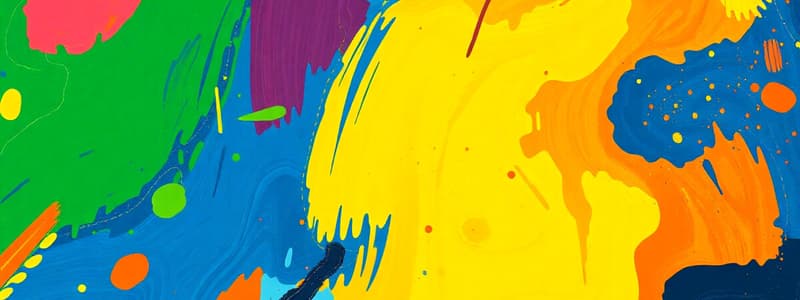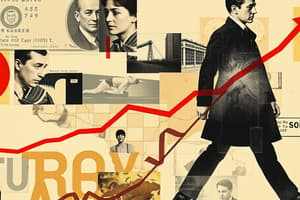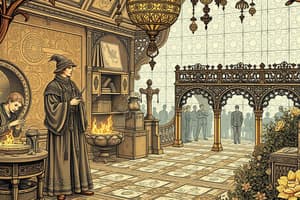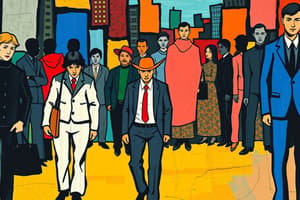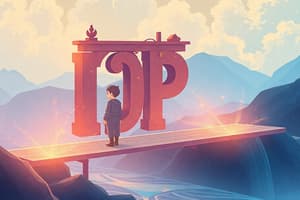Podcast
Questions and Answers
What is opportunity cost?
What is opportunity cost?
The value of the best alternative forgone when making a choice.
What does the Paradox of Thrift state?
What does the Paradox of Thrift state?
Increased saving, while beneficial for individuals, can lead to decreased aggregate demand and, subsequently, reduced economic output and employment.
What happens when labor force participation goes up?
What happens when labor force participation goes up?
It leads to an increase in the supply of labor, potentially lowering wages and increasing output in the economy.
What is the difference between GDP (C + I + G + NX) and real GDP?
What is the difference between GDP (C + I + G + NX) and real GDP?
What are CPI and a consumer price index?
What are CPI and a consumer price index?
What is the difference between Nominal GDP and Real GDP?
What is the difference between Nominal GDP and Real GDP?
What are cyclical and natural unemployment?
What are cyclical and natural unemployment?
What is the meaning of a unit of account?
What is the meaning of a unit of account?
What is the definition of "Paradox of Thrift"?
What is the definition of "Paradox of Thrift"?
What is the definition of "labor force"?
What is the definition of "labor force"?
Cyclical unemployment is a result of a lack of demand.
Cyclical unemployment is a result of a lack of demand.
Natural unemployment is a result of structural changes in the economy.
Natural unemployment is a result of structural changes in the economy.
What is the relationship between the short-run aggregate supply curve and the long-run aggregate supply curve?
What is the relationship between the short-run aggregate supply curve and the long-run aggregate supply curve?
What does "o multiplier" mean?
What does "o multiplier" mean?
The price level affects the aggregate supply in the long run.
The price level affects the aggregate supply in the long run.
Flashcards
Opportunity Cost
Opportunity Cost
The value of the best forgone alternative when making a choice.
Paradox of Thrift
Paradox of Thrift
Increased saving can decrease overall economic activity.
GDP
GDP
The total value of all final goods and services produced in an economy.
GDP Components
GDP Components
Signup and view all the flashcards
Consumption (C)
Consumption (C)
Signup and view all the flashcards
Investment (I)
Investment (I)
Signup and view all the flashcards
Government Spending (G)
Government Spending (G)
Signup and view all the flashcards
Net Exports (NX)
Net Exports (NX)
Signup and view all the flashcards
Frictional Unemployment
Frictional Unemployment
Signup and view all the flashcards
Structural Unemployment
Structural Unemployment
Signup and view all the flashcards
Cyclical Unemployment
Cyclical Unemployment
Signup and view all the flashcards
Nominal GDP
Nominal GDP
Signup and view all the flashcards
Real GDP
Real GDP
Signup and view all the flashcards
CPI
CPI
Signup and view all the flashcards
Cost of Living
Cost of Living
Signup and view all the flashcards
Inflation
Inflation
Signup and view all the flashcards
Interest Rates
Interest Rates
Signup and view all the flashcards
Government Policy
Government Policy
Signup and view all the flashcards
Multiplier Effect
Multiplier Effect
Signup and view all the flashcards
National Savings
National Savings
Signup and view all the flashcards
Supply and Demand of Loans
Supply and Demand of Loans
Signup and view all the flashcards
What Influences Interest Rates?
What Influences Interest Rates?
Signup and view all the flashcards
Bonds
Bonds
Signup and view all the flashcards
Stocks
Stocks
Signup and view all the flashcards
Bank Deposits
Bank Deposits
Signup and view all the flashcards
Impact of Inflation on Loans
Impact of Inflation on Loans
Signup and view all the flashcards
Tax Changes and Interest Rates
Tax Changes and Interest Rates
Signup and view all the flashcards
Government Spending and Real GDP
Government Spending and Real GDP
Signup and view all the flashcards
Multiplier Effect of Government Purchases
Multiplier Effect of Government Purchases
Signup and view all the flashcards
Multiplier Effect of Taxation
Multiplier Effect of Taxation
Signup and view all the flashcards
Relationship between Real GDP and Economic Indicators
Relationship between Real GDP and Economic Indicators
Signup and view all the flashcards
Relationship between National Savings and Economic Indicators
Relationship between National Savings and Economic Indicators
Signup and view all the flashcards
Loan Types and Interest Rates
Loan Types and Interest Rates
Signup and view all the flashcards
Study Notes
Economic Concepts
- Scarcity: Limited resources, forcing choices.
- Opportunity Cost: Value of the next best alternative forgone.
- Producer Surplus: Difference between market price and minimum price a producer is willing to accept.
- Paradox of Thrift: Increased saving can lead to decreased spending and a lower GDP when there is reduced demand.
- Labor Force: Individuals employed or actively seeking employment.
- Labor Participation Rate: Percentage of labor force in the labor force.
- Unemployment: Individuals actively seeking work but unable to find it.
- Frictional Unemployment: Temporary unemployment while searching for a new job.
- Structural Unemployment: Unemployment due to a mismatch between available job skills and available jobs.
- Cyclical Unemployment: Unemployment resulting from fluctuations in the business cycle.
- Natural Unemployment: The rate of unemployment that occurs when the economy is at full employment.
Economic Measures
- GDP (Gross Domestic Product): Total market value of all final goods and services produced in a country in a given period.
- CPI (Consumer Price Index): Measures the average change over time in the prices paid by urban consumers for a basket of consumer goods and services.
- Nominal GDP: GDP measured in current market prices.
- Real GDP: GDP adjusted for inflation, expressed in constant prices.
- PPI (Producer Price Index): Measures the average change over time in prices received by domestic producers for their output.
Economic Relationships
- GDP Formula: GDP = C + I + G + NX (Consumption + Investment + Government Spending + Net Exports).
- Inflation: A general increase in the average price level of goods and services in an economy over a period of time.
- Deflation: A general decrease in the average price level of goods and services in an economy over a period of time.
Studying That Suits You
Use AI to generate personalized quizzes and flashcards to suit your learning preferences.
